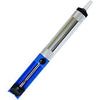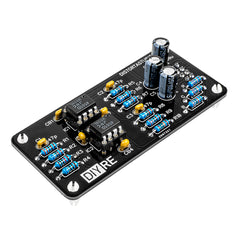Distortastudio Assembly Guide
Damaged or Missing Parts All kits and parts are checked before being shipped to you. If something arrives damaged or if your kit is missing a part, please open a support ticket to inquire about a replacement. Missing parts will be replaced at our expense. Damaged parts should be returned for verification. If the part shows signs of use beyond what was necessary to determine that it was damaged, DIY Recording Equipment, LLC reserves the right not to replace the part.
Thank you for purchasing a Distortastudio Cassette 4-Track Colour!
If this is your first DIY project ever, we recommend reading our Getting Started Guide.
Required Tools
You'll need the tools below to complete this build.

Soldering Iron
We recommend an adjustable-temperature station, such as the $40 Weller WLC100.

Solder
You can use 60/40 "leaded" solder or lead-free. We recommend 60/40 because it flows better and is easier for beginners to use.

Wire Cutters
You'll need a pair of good "snips" for cutting of the excess leads after soldering.
Optional Tools
These tools aren't strictly necessary but can make your build a bit easier.

Multi-Meter
If you find the color bands on resistors a bit hard to read, you can use a meter to sort them with absolute confidence.

Desoldering Pump
If you accidentally solder something in the wrong place, a desoldering pump can save the day.
0. Resistor Calculator
Type in the value of the resistor you need and this tool will show you the corresponding color code.
Check Revision
This assembly guide is for Rev A of the Distortastudio, which was discontinued in March 2023. If you bought your kit after March 2023, go to the new Distortastudio assembly guide.
Place Resistors

Place Resistors
When placing a resistor, bend the resistor leads so that they can easily fit into the PCB, and place them in the in the spots labeled with the matching values on the board.

Bend Resistors
Bend the resistor leads flat to the underside of the PCB. This will hold them in place when flipping the PCB over to solder.

Solder Resistors
Solder the resistors to the PCB. Heat each pad and lead for 2-3 seconds, apply a small bit of solder, and continue to heat the pad for another 2-3 seconds. Allow each solder joint 10 seconds to cool before moving on to the next one. The finished joints should be shiny and should have just enough solder to cover the pad entirely. After that, trim the excess leads of the resistors to get them out of the way.
Place Capacitors and Sockets

Identify Ceramic Capacitors
The are two types of ceramic caps in this kit. One is 0.1 uF (CB1 - CB4) and the other is 47pF (C1 - C3). Here is a picture to demonstrate and hopefully alleviate the confusion. On the left is CB1-CB4, and on the right is C1 - C3. Whew! Alright, good work everybody. Time to place those caps!

Place Ceramic Capacitors
Place the Capacitors on the PCB and bend their leads to hold them to the board. Then, solder the capacitors and trim their leads.

Place and Solder IC Sockets
Make sure the notch on the socket lines up with the drawing on the PCB. You will probably want to secure the sockets to the board somehow during soldering. Perhaps with a piece of scotch tape. Then flip the PCB over and solder the sockets in place.

Place and Solder Electrolytic (Polar) Capacitor (C6)
When placing C6, take note of polarity marking on the PCB. Weirdly, on the PCB they mark which side is positive but on the capacitor itself they mark which side is negative. The negative side of C6 is marked with a grey stripe down the side that has minus symbols in it.


Place and Solder Electrolytic (Non-Polar) Capacitors (C4 & C5)
The other two electrolytic capacitors are bi-polar meaning they have no preference as to how they go on the PCB. They also don't have a grey stripe on them.
Place ICs and Connectors

Bend IC Leads
See how the pins of the IC protrude from the body at slightly wider than a 90 degree angle? In order to fit the IC into the socket, we'll need to bend the leads inward a bit. Set the IC on its side and press from the other side to bend all the leads at once. Then flip the IC over and do the same for the other side. When you are done the leads should be perpendicular to the body.

Install ICs
The ICs are both the same, so it doesn't matter which one goes where. When placing the ICs in the IC sockets make sure the dot on the top of the IC is facing the notched side of the IC socket. This will ensure happiness.

Place and Solder Header
Place the 8-pin header through the bottom of the PCB so that the long, gold pins are pointing away from the PCB. These are the pins that will mate with the Colour Palette. Solder the header—there's no need to trim after soldering.

Install Plastic Stand-offs
Snap the standoffs into the PCB so that they protrude outward on the same side as the 8-pin connector. The side with a rigid edge is the side you insert into the PCB.
Final Checks
Before you wrap up, check the following things:
-
Capacitor orientation: Is the stripe on the cap on the opposite side from the "+" marking on the PCB?
-
IC orientation: Does the dot/notch on the IC align with the notches on the socket and PCB?
-
Diode orientation: Do the stripes on the diode match those on the PCB?
-
Resistors: Do all of the resistor positions correspond the chart and/or sorting sheet?
-
Soldering: Is every solder joint shiny and clean? If one is cloudy or misshapen, try reheating it for 8 seconds and adding a tiny bit more solder.
-
Trimming: Are all of the excess leads trimmed down as close to the joint as possible?
All good? Congrats on finishing your build! Have a question or problem? Drop us a line.
Help Us Improve
1
2
3
4
5
6
7
8
9
10



